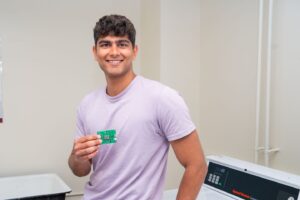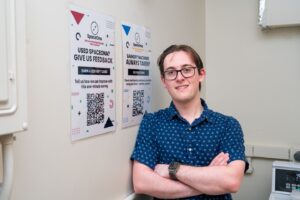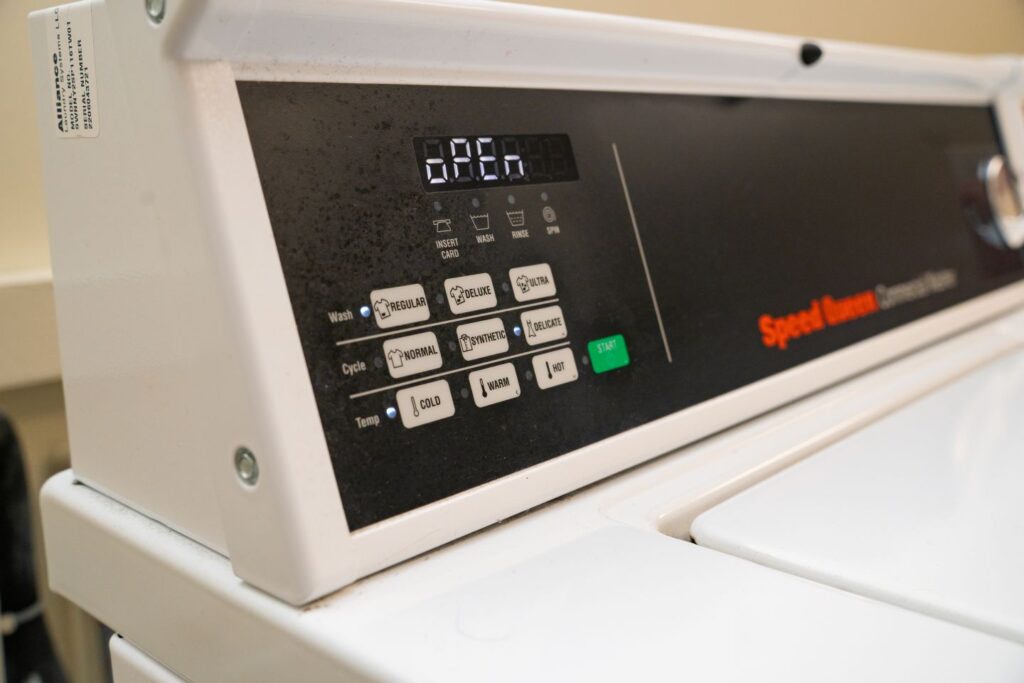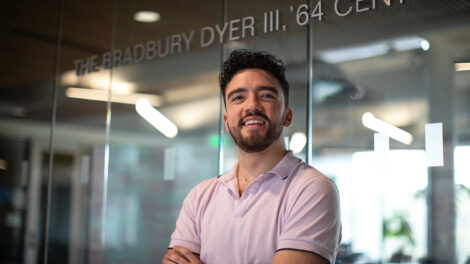Wash, rinse, spin
By Bryan Hay
Doing laundry is a time-consuming necessity for anyone, perhaps more so for college students who often take a chance on unit availability or strategically plan their laundry room visits during times of low demand. There’s never any guarantee that a washing machine will be free for use.
But over the past several years, a group of determined, enterprising Lafayette students came up with an idea to save time by placing compact motion sensors on Watson Hall washers and dryers and developed a website that displays the availability of each unit. The sensors detect vibrations on the four washers and four dryers, and the data is captured and displayed on SpaceOna, the student-led startup that provides real-time usage information.
“We have vibration sensors that sense how the washing machines are running based on the vibration patterns that are sent over Wi-Fi to our server,” explains Kashif Chopra ’26 (electrical and computer engineering) who helped create SpaceOna, which won first place in the 2023 Big Idea Competition sponsored by Dyer Center for Innovation and Entrepreneurship.

Kashif Chopra ’26 | Photo by JaQuan Alston
SpaceOna was first developed to solve the problem of finding available study rooms on college and university campuses, allowing students to view the occupancy of the rooms in real time, using motion detection technology.
As students learned about SpaceOna, they approached Chopra about adapting it for laundry rooms.
“We did a survey and it got about 140 responses, and we put up posters in different laundry rooms throughout campus to ask if this is a problem,” he says. “And just the fact that so many students responded to us showed us this is a clear need.”
Watson Hall was identified as the pilot location.
“It’s a large dorm with only four washers and dryers. There’s always a lot of pressure on the units over there,” Chopra adds. “So that’s how we decided this problem was worth working on, and we began moving forward with the project.”

Kashif Chopra ’26, Sam Satalof ’26, and Robbie Leslie ’25 celebrate a successful laundry sensor project. | Photo by JaQuan Alston
Sam Satalof ’26 (electrical and computer engineering), part of the project team, lived in Watson Hall his first and sophomore years, and brought his own observations and experiences to the table. He remembers all too well Watson’s four floors without elevators and lugging bags of laundry to the basement laundry room.
“You have two or three hours to get laundry done, and you come down to find all the machines are taken,” he laughs. “You just never know what the situation will be. This system helps solve the problem.”

Sam Satalof ’26 | Photo by JaQuan Alston
“We were looking at this system as a time-saver and providing convenience,” Satalof adds. “Doing laundry is a hassle for students. When you eliminate these smaller hassles, you can focus on more important things. That guided our long-term vision.”
The long-term goal is to install the sensors in as many campus laundry rooms as possible and connect them to the College’s Wi-Fi network.
Team member Robbie Leslie ’25 (electrical and computer engineering) says the project was purely Lafayette because it arose organically and offered a chance to work on something very meaningful in an independent way.

Robbie Leslie ’25 | Photo by JaQuan Alston
“I just went and taught myself how to make the printed circuit boards. I taught myself a lot of the coding and circuitry that was needed,” he says. “It’s been good for my Lafayette education, because it allowed me to show, outside of my classes, that I have these technical skills. And it’s really helped me in other areas, like my senior design, where I’ve been a leader technically, because I’ve done projects like this.”
Like other Dyer fellows before him, Chopra says he wanted to leave a lasting legacy at Lafayette after he graduates.
“As an electrical and computer engineer you tinker around with things,” he says. “But we’re always encouraged to apply these skills to a specific problem. Taking what we’ve done in class and being able to apply those skills outside on a specific problem is something that only can happen at a small school like Lafayette.
“My journey here not only included being able to work on the actual project itself, but seeing all the different moving parts around it,” he adds. “Being able to build such a great team was a huge learning opportunity for me personally, because you need to find the people who are also excited about this, and then tie everyone together to be able to work toward a common goal.”
“To be able to accomplish a goal that improves the lives of fellow students with support from the campus community and a dedicated, interdisciplinary team of students “was just an incredible experience,” Satalof says.
Chopra, Leslie, and Satalof were joined on the project team by Christopher Kirch ’26 (economics major and co-founder of SpaceOna in March 2023); Prem Kumar ’26 (environmental studies and international affairs and co-founder of SpaceOna in March 2023); Hasnat Aslam ’27 (economics and philosophy); Jack Cross ’27 (electrical and computer engineering); Jack Ewing ’28 (electrical and computer engineering); and David Green ’27 (electrical and computer engineering).

All of the washers and dryers in Watson Hall are equipped with motion sensors | Photo by JaQuan Alston
Dyer Center, the College’s Data Center, and Justin Smith, assistant professor of computer science, have all been very supportive of the initiative, says Chopra, a Dyer Center fellow.
“It’s just really cool when students recognize some need or opportunity in their own communities, and then they apply all the things they’re learning in their various classes to address that need,” Smith observes.
“What really struck me about this project in particular is that they’re like trying to improve something for themselves and their classmates, and applying a variety of skills in order to accomplish it,” he adds.
From the point of view of a computer science professor, Smith was particularly impressed by how the students successfully managed the myriad complexities of acquiring the technical parts of the system and getting them working, and then reaching the right administrators on campus to get permission to install the sensors.
“That’s the liberal arts side of it. You have to make a good product, but then you have to convince all the right stakeholders to implement it,” Smith says.
“The thing I love about Lafayette the most is that moment before and after class where you’re just kind of milling about, and you can wander through the classroom and get to know what students are up to outside of the class,” Smith beams.
“This all came about through one of those conversations. I remember saying, ‘that’s a pretty neat thing you’re doing,’” he recalls. “All of my students have neat things they’re doing outside of their regular coursework. But this one really kind of struck me as like you’re doing something cool here. Something that’s really Lafayette.”

